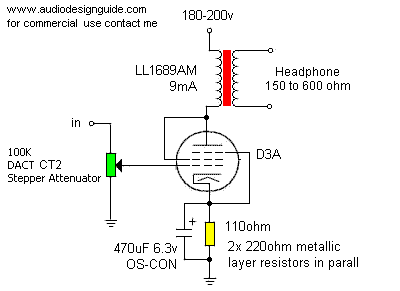INTRODUCTION In these years there was many interest about my SESS Tube Headphone Amplifier published on Headwize because it is simple and it give a very good sound. Now I have decided to start a new project using all my new experiences and the best components on the market like the new amorphous C-core by Lundahl.
OLD and NEW
There are few differences but these give a very strong upgrade.

The LL1630/10mA has been replaced with LL1689AM/9mA because this new type have an higher inductance and a little bit higher turn ratio to have more low frequency band and less output impedance.
Both the types has been used with primaries in series so a LL1630/10mA is good for 20mA bias current and LL1689/9mA for 18mA.
| model | LL1630/5mA | LL1630/10mA | LL1689/18mA | LL1689/9mA |
| primary inductance in series (H) | 130 | 65 | 90 | 180 |
| primary inductance in parallel (H) | 32.5 | 16.25 | 22.5 | 45 |
It is obvious that is not possible use the primaries in series, to get the max inductance, because in this case the voltage gain of the tube will be not enough.
With the LL1689 we have a good value of 45H that mean a low frequency band of F(-3db) = 6.4Hz with a tube like D3A.
I have used the D3A instead of 5842 because the LL1689 have a turn ratio 1:9 instead of 1:7 so to compensate this it is necessary a vacuum tube with more gain.
Using the D3A we have 6Vrms on output with only 0.77Vrms in input.
6 / 0.77 * 9 = 70 (D3A gain)
so with 5842 to get 6Vrms will be necessary 6 * 9 / 42 (5842 gain) = 1.28Vrms
Follows the calculation of the necessary output voltage and current using a Beyerdynamics DT880
Nominal impedance acc. to IEC 60268-7 250 Ω Nominal SPL acc. to IEC 60268-7 96 dB Nominal THD acc. to IEC 60268-7 < 0.2% Power handling capacity acc. to IEC 60268-7 100 mW
Power = Vrms * Irms
Irms = Vrms / R
Power = Vrms * Vrms / R
Vrms = sqrt(Power * R) => sqrt(0.1 mW * 250 ohm) = 5 Vrms
Irms = 5 Vrms / 250 ohm = 20 mA
The output impedance has been measured in 34ohm so this amp. is good to drive headphone in the range 150-600 ohm with a good damping factor.

The D3A is a very good vacuum tube in triode connection and it give a very good sound.
If you prefer the sound of the 5842 it is possible use this but I suggest to check the sensibility with a simple test with your source.
Off course to get max sonic performances this amplifier should be connected directly to the sources as CD player, DAC and Phono pre-ampl.
Using the amorphous C-core there is a sure improvement in sonic performances and their price are not excessive.
On cathode the by-pass are good Sanyo OS-CON capacitors considered better than old ELNA Cerafine and Black Gate.
The operation point of the D3A has been the result of many measurement with the Clio system by Audiomatica.
I have got 10Vrms at 0.5% thd without load and 6.8Vrms at 2% thd on 150ohm (see plot), always with a perfect distortion decay.

Low freq. cut-off 17Hz at -3db and 30Hz - 22KHz at -0.5db

POWER SUPPLY
To get the max sonic performances and long vacuum tubes life has been used a slow turn on power supply for the filaments and a virtual battery operation power supply for the anodic.
It is possible use the passive power supply used in the SESS Tube Headphone Amplifier published on Headwize.

For this power supply I have used the R-CORE model R26-90 by DiyClub.Biz with primaries 2 x 115v and seconaries 0-165v(0.2A) + 2 x 0-9v (1.1A).
A good capacitor must be connect on anodic voltage output, 100uF or 220uF Blackgate or Jensen electr. or ELNA Cerafine.
